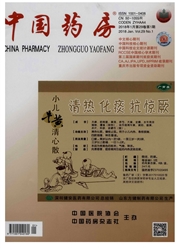

 中文摘要:
中文摘要:
目的:探讨与评价降钙素原(PCT)对重症监护病区(ICU)发热患者血流感染(BSI)的诊断及预测价值。方法:回顾性分析2012年3月-2014年12月我院ICU233例发热患者的病历资料,比较不同血培养结果、不同病原菌类型和不同细菌种类感染患者血清PCT和C反应蛋白(CRP)水平的差异,采用受试者工作特征(ROC)曲线评价和比较PCT、CRP对BSI的诊断及预测价值。结果:233例发热患者中,血培养阳性患者有74例,阳性率为31.76%;血培养阳性患者血清PCR、CRP水平均高于血培养阴性和污染患者,差异均有统计学意义(P〈0.001);而血培养阴性患者与污染患者血清PCR、CRP水平比较,差异均无统计学意义(P〉0.05)。74例血培养阳性患者中,革兰氏阴性菌感染患者45例,占60.81%;革兰氏阳性菌感染患者18例,占24.32%;真菌感染患者11例,占14.86%;革兰氏阴性菌感染患者血清PCT水平显著高于革兰氏阳性菌和真菌感染患者,革兰氏阳性菌感染患者血清PCT水平也显著高于真菌感染患者,差异均有统计学意义(P〈0.05);但3种病原菌感染患者血清CRP水平比较,差异无统计学意义(P〉0.05)。发热患者感染的主要细菌包括不动杆菌、金黄色葡萄球菌、铜绿假单胞菌、大肠埃希菌和肺炎克雷伯菌;各细菌感染患者血清PCT水平比较,差异均有统计学意义(P〈0.05);而其血清CRP水平比较,差异无统计学意义(P〉0.05)。ROC曲线分析结果显示,PCT和CRP对区分血培养阳性与阴性均有统计学意义(P〈0.001),ROC曲线下面积(AUROC)分别为0.789[95%置信区间(CI)(0.732,0.845)]和0.629[95%CI(0.568,0.690)],截断值分别为1.2ng/ml和81.4mg/L;PCT和CRP对区分血培养阳性与血培养污染亦均有统计学意义(P〈0.001),AUROC分别为0.805[95%CI(0.711,0.899)]和
 英文摘要:
英文摘要:
OBJECTIVE: To investigate and evaluate the diagnostic and predictive value of procalcitonin (PCT) for ICU fever patients with bloodstream infections(BSI). METHODS: Medical records of 233 ICU fever patients in our hospital during Mar. 2012 to Dec. 2014 were analyzed retrospectively. Serum levels of PCT and CRP were compared among patients with different blood cul- -tre results, pathogen types and species of bacterial infection. The diagnostic and predictive value of PCT and CRP for BSI were evaluated and compared by using ROC curves. RESULTS: Among 233 fever patients, there were 74 cases of positive blood culture with positive rate of 31.76%. The serum levels of PCR and CRP in patients with positive blood culture were higher than in those with negative blood culture and contamination, with statistical significance (P〈0.001). There was no statistical significance in serum levels of PCR and CRP between negative blood culture group and contamination group (P〉0.05). Among 74 patients with positive blood culture, there were 45 cases of gram-negative bacterial infection, accounting for 60.81%; 18 cases of gram-positive bac- terial infection, accounting for 24.32%; 11 cases of fungi infection, accounting for 14.86%. Serum level of PCT in patients with gram-negative bacterial infection was higher than in those with gram-positive bacterial infection and fungi infection, and serum level of PCT in patients with gram-positive bacterial infection was higher than in those with fungi infection, with statistical signifi- cance (P〈0.05). There was no statistical significance in serum level of CRP among patients with 3 kinds of bacterial infection (P〉 0.05). Main bacteria of infection in fever patients included Acinetobacter, Staphylococcus aureus, Pseudomonas aeruginosa, Escherichia coli and Klebsiella pneumoniae; there was statistical significance in serum level of PCT among various bacterial infection (P〈0.05) ; there was no statistical significance in serum level of CRP (P〉0.05)
 同期刊论文项目
同期刊论文项目
 同项目期刊论文
同项目期刊论文
 期刊信息
期刊信息
